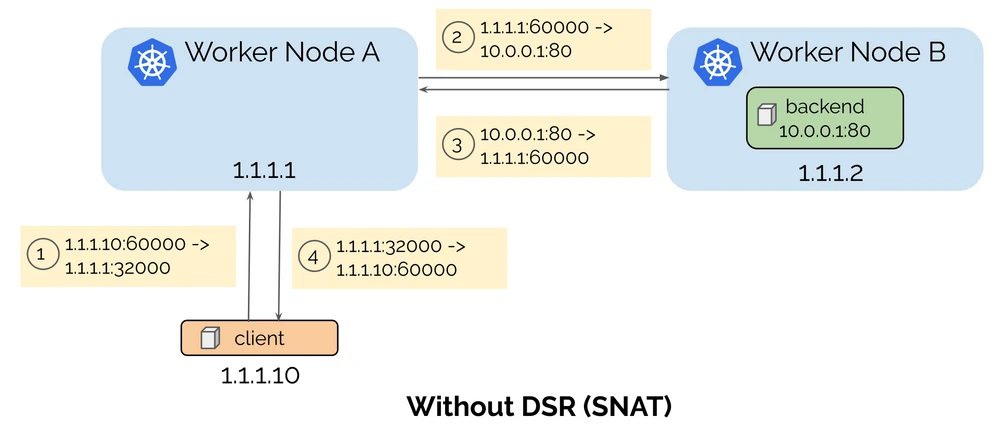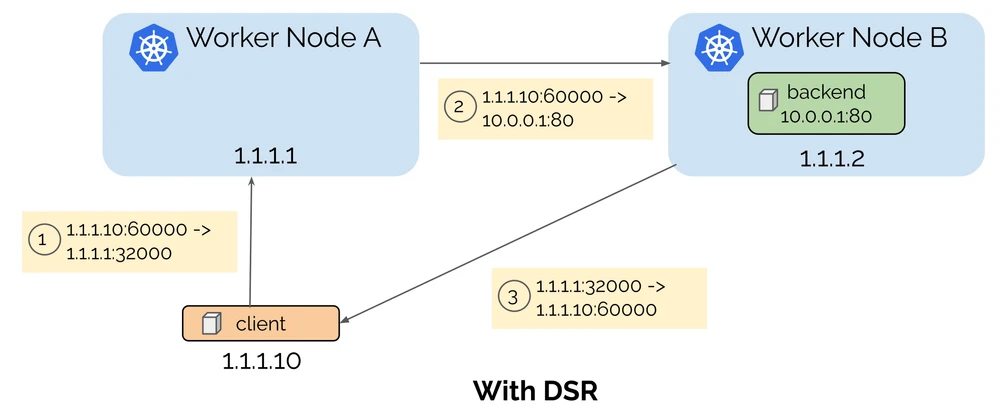You can use the cni-cilium module
to configure the BPF Load Balancer (bpfLB) mode of operation in Deckhouse Kubernetes Platform.
In Kubernetes, traffic typically comes through a load balancer that distributes incoming requests among servers and processes responses. Thus, the total throughput is limited by the load balancer resources.
To optimize traffic and unload the balancer, the DSR mechanism is used,
in which incoming packets go through the load balancer, and outgoing ones go directly from the terminating servers.
Since responses are usually much larger in size than requests, this approach can significantly increase the overall throughput.
The module allows selecting the mode of operation via the bpfLBMode parameter,
which affects the behavior of Services of the NodePort and LoadBalancer types:
SNAT(Source Network Address Translation): A subtype of NAT in which, for each outgoing packet, the source IP address is translated to the IP address of the gateway from the target subnet, and incoming packets passing through the gateway are translated back based on a translation table. In this mode,bpfLBfully replicates the logic ofkube-proxy:- If
externalTrafficPolicy: Localis specified for a Service object, the traffic will be forwarded and balanced only to those target pods running on the same node where the traffic arrived. If the target pod is not running on this node, the traffic will be dropped. - If
externalTrafficPolicy: Clusteris specified for a Service object, the traffic will be forwarded and balanced to all target pods in the cluster. At the same time, if the target pods are located on other nodes, SNAT will be performed when transmitting traffic to them (the source IP address will be replaced with the InternalIP of the node).

- If
DSR(Direct Server Return): A method where all incoming traffic passes through the load balancer, and all outgoing traffic bypasses it. This method is used instead ofSNAT. Often, responses are much larger than requests, andDSRcan significantly increase the overall throughput of the scheme:- If
externalTrafficPolicy: Localis specified in theService, its behavior is completely analogous tokube-proxyandbpfLBinSNATmode. - If
externalTrafficPolicy: Clusteris specified in theService, the traffic will be forwarded and balanced to all target pods in the cluster. Note the following:- If the target pods are on other nodes, then the source IP address will be preserved when incoming traffic is sent to them.
- Outgoing traffic will go directly from the node on which the target pod was launched.
- The source IP address will be replaced with the external IP address of the node to which the incoming request came originally.

In case of using
DSRandServicemode withexternalTrafficPolicy: Clusteradditional network environment settings are required.
Network equipment must be ready for asymmetric traffic flow: IP address anti-spoofing tools (uRPF,sourceGuard, etc.) must be disabled or configured accordingly.- If
Hybrid: In this mode, TCP traffic is handled perDSRrules, while UDP traffic is handled perSNATrules.
Example of bpfLB operation mode configuration:
apiVersion: deckhouse.io/v1alpha1
kind: ModuleConfig
metadata:
name: cni-cilium
spec:
settings:
tunnelMode: VXLAN
bpfLBMode: SNAT # SNAT mode is selected.
version: 1
enabled: true